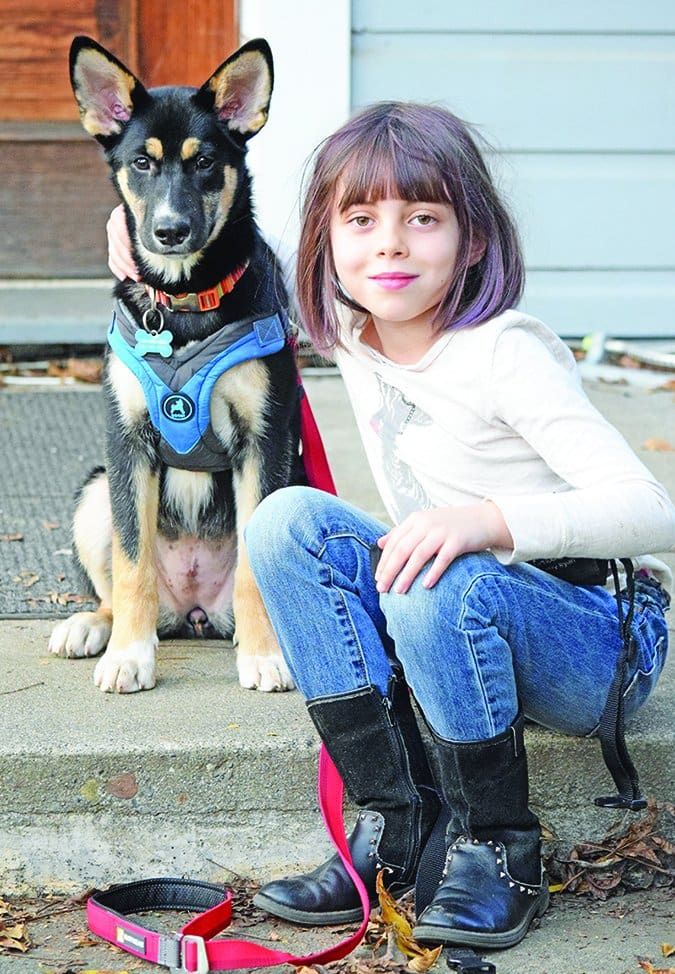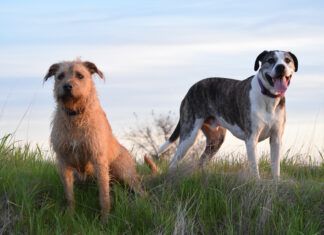Just about everyone knows to be prepared to deal with crazy/relentless puppy behavior, but way fewer dog owners, it seems, have been warned about the other challenging period in a dog’s life: adolescence! A quick Google search on the topic produces results peppered with words like “surviving,” “dealing with,” and “misbehavior.” These pages offer up a long list of things that can go wrong when dealing with teenage dogs, and suggest it will be more than difficult to get through. Goodness, it sounds horrible! It’s true that this period involves a ton of changes to your dog’s biological, physical, and psychological makeup. By extension, his behavior is affected. It’s also true that there are times when this transformation is accompanied by some challenging moments. But rest assured it’s not all doom and gloom! For every challenging feature of canine adolescence, there is an equally awesome element that makes this a very special time. The adolescent period typically begins around six months of age, and will be over when a dog reaches physical maturity around two to three years old. The most pronounced behavioral issues will be noticed between six to 12 months old. Keep in mind that although hormones have a lot to do with adolescent changes, they’re not the only thing responsible for some of the behaviors you may see (even neutered dogs will exhibit these behaviors). Your dog’s brain is growing and developing, and the apparent quirkiness of the process is all perfectly natural. As a trainer and a person who is currently in the adolescent trenches with my Border Terrier, Bennigan, I can testify that it’s not all bad. Here are some facts about canine adolescence that you may not be aware of, and some tips that, I hope, will help guide you through this challenging time with your “teenaged” dog.
1. Bonding with your teenage dog is important.
The foundation of your relationship with your dog is taking shape and getting stronger. If you’ve had your adolescent dog since puppyhood, time has been on your side. You’ve had several months to get to know each other and to build a bond. That’s a very good thing. It’s always much easier to forgive and to exercise patience with someone (or a dog) we care deeply about. So while puppyhood antics may have pushed your buttons and left you scrambling for a moment’s peace for several weeks in a row, adolescent shenanigans can be surprisingly easier to tolerate, thanks to that bond. You’ll still need to draw deeply from the patience pool during this time, but by now your dog will have improved in other departments: He’ll know some basic cues thanks to your training; he’ll be housetrained; and his needs won’t always require an immediate response on your part, like when he was a young pup.

2. Teething is almost done!
Most of the really difficult teething phase occurs before adolescence, and while it doesn’t really wrap up until about seven to nine months old (on average), it’s not nearly as dramatic as the earlier stages. Some dogs remain power chewers throughout their adult life, however, and it’s important to evaluate and adjust the types of chew toys you’re giving your adolescent dog. What was suitable for a five-month-old puppy might no longer represent a safe option for your dog’s newer and more powerful jaw. For example, if it used to take him an hour to work his way through a bully stick several weeks ago, it might now only last him 10 minutes and he should be watched closely. Or he may now be able to chew off chunks of a chew stick that previously he could barely dent.
3. Adolescent dogs have different sleeping schedules.
Remember when your puppy used to spend more time asleep than awake? Yes, well. Those days are gone. Your teenage dog now seems to have access to an endless supply of energy! If you arm yourself with lots of short, fun training sessions and brain games, you’ll fare much better than if you rely solely on physical exercise to tire out your young dog. Besides, you’ll want to avoid any serious physical activity that involves sudden stops and turns, or jumps and bounces. Your dog’s skeletal structure isn’t quite done taking shape yet, and you’ll want to protect his joints until at least 12-18 months of age, depending on his size. (Speak to your vet for advice about this.) Back to sleeping: Your teen dog will very likely experience some disruptions in his nighttime sleeping pattern, which means you’ll also experience a few sleepless nights. He might snooze the entire evening away, and just when you’re ready to call it a night at 11 pm, he’s suddenly wide awake and ready to party! There’s little you can do to convince him to settle down. Don’t worry. These episodes will come and go, and all that’s needed is a little bit (okay, a lot) of patience and time.
4. Socializing your teenage dog is important!
Socialization needs to continue. You’ve done a wonderful job socializing your pup during the sensitive socialization period (before 12-16 weeks of age), but it shouldn’t stop now that your dog is a teenager. Even if you’ve just adopted an adolescent dog and his socialization history is unknown, it’s important to continue to carefully expose your dog to different places, people, other dogs, and different situations (like riding in the car) while associating these events with something positive. You might notice that your dog may quite suddenly appear wary or even fearful of things or situations that he previously had no issue with. This is normal. These moments will come and go several times during adolescence and may last anywhere from a couple of days to a few weeks. He may give a scary fire hydrant a very wide berth during your walk, or he might decide that new people or dogs (or trees, or shadows) should be barked at. Don’t worry. Handle these moments with calm and patience, and understand that your dog isn’t always able to control his emotions during these phases. Don’t push or force him to “confront his fear,” and don’t scold him for what may look like rude behavior. Give him time to process whatever spooked him. If he wants to turn away and avoid the scary thing, that’s fine. If he barks at it, that’s fine, too. Often, just crouching next to him and talking with a gentle voice is enough to calm the barking.
Some people “lay low” when they notice their dog is experiencing a fearful phase, opting to avoid situations that cause their dog stress, like busy streets or large crowds (such as a fair or a dog sporting event). When their dog shows signs he’s feeling more confident, activities resume as normal.
5. Teenage dogs become more interested in going for walks.
Many young puppies balk at wandering too far away from the safety of home. They’ll take a few steps on-leash and then will suddenly slam on the brakes and stand still like a statue. Nature designs them this way, for good reason. Adolescence serves to create just the opposite: A biological urge to wander further from the nest and to explore new places. You’ll notice your adolescent dog also has more stamina to keep up with you during daily walks, and that he enjoys investigating the various scents. Adventures with your dog now become a lot more fun. Resist the urge to let him off-leash, unless you’re in a safely fenced area. Remember that he’s genetically predisposed to explore! His recall isn’t nearly as reliable as it was when he was a puppy (very normal), so don’t count on how good he was just a few weeks ago. Use a long leash if you want to give him more freedom. Keep practicing calling him back to you and reward him with a very yummy treat every time he comes. You’ll want to maintain this high rate of reinforcement until he’s an adult. Speaking of unreliable cues…
6. Your dog’s training might seem to come and go.
Remember how proud you were of your puppy’s training results? How quickly he learned to sit, to lie down, to come, to leave it, to drop it, etc.? Where did all of those skills go? If it seems as though your dog has forgotten all of his training, don’t worry – he hasn’t. The information is still there, floating around in that rapidly developing brain of his. He’s just having a bit of trouble accessing all that knowledge right now. This too will return to normal when he’s done with the teenage phase. Keep teaching, keep rewarding, and keep breathing. All of your efforts will pay off later. Nancy Tucker, CPDT-KA, is a full-time trainer, behavior consultant, and seminar presenter in Quebec, Canada. Her Border Terrier, Bennigan, is smack dab in the middle of adolescence.







Oh my goodness! This explains my six month old puppy behavior! She’s forgotten things that she’s done for months and she looks at me like I’m clueless when I give her a command that she’s done for months with no problem. She was doing well off leash and then all the sudden one day I called her she tilted her little head at me and then took off in the opposite direction ignoring my commands to heel. She looks at me when I tell her to do something and I can see the wheels turning in her head as she does the opposite of what I tell her. Running away with her tail wagging! It is funny and it reminds me totally like a child. The article was excellent!
Dog needs a good home in airport please me and Matthew like to buy one have one was going for free what is good with cats and other dogs we would like to take good care of it good loving and feed it every time and take it out for a walk every time because we want a dog to girl dog please I would take it out I’m Good and Ready up in my house is clean and tidy and I have got a big garden live I live at flat 40 in Chichester Argos Road I would like to take good care of the dogs cause I love him and I would like to me girl doll please I will take good care and good loving and I would like to have one please thank you very much can you get back to me or touch me please thank you very much Gemma Oakley and Matthew Smith Maggie Smith
Wish the article addressed more about the older 1-3yo adolescent dog since that is when sexual drives peak, coping with physical strength becomes challenging, and aggression can develop as they may try to assert themselves more.
My boy is 17 months old and it seems as though he is not so much challenging me but pushing the buttons a bit to much keeps barking at me as though he saying “yeah what you gonna do about me barking at you then ” sort of testing how daft he can go.
This was so great, my 9 month old pup has been exhibiting so many of these behaviors. Thank you for the calming and normalizing article.
My dog just turned 1 so should her sexual drive be really high right now or no, because she hasn’t shown any signs of it being high.
Thank you so much. I have been a bit worried about my puppy the last few weeks (she’s 7months) and also felt I had been failing training wise when everything she’s learnt went out the window all of a sudden.. She is displaying every single one of these points and I was concerned something was wrong… all makes sense now! Thank you!!
My 7 month old husky, Fergus, is going through this right now. Luckily I’ve had enough dogs to recognize puppy puberty, and I have to laugh at his antics. He was altered about ten days ago, and let me tell you, keeping him still (HAHAHAHA) is impossible, so we’re always checking his sutures. He probably thinks I’m a weirdo. So far, he remembers his training, although he’s balking at “shake”….luckily, we have a 5 year old GSD who knows all these and will sit by him and show off his skills in order to get a treat. I know it’s just beginning, and I’m ready for the ride.
My dog is 7years n recently started thru the night scratching at door how do I stop it
Yup! This sounds like my 11mos old Goldendoodle!I have owned and trained a lot of dog breeds from 8 weeks old and this is the first time I have experienced such a dramatic fear phase in an adolescent puppy! Your advice is helpful, especially just reading about these symptoms and behaviors.